When you’re considering foundation solutions in Stoney Creek, Ontario, helical pier installation stands out due to its adaptability to the area’s challenging soil conditions, like expansive clay and frost heaving. These piers offer immediate load transfer and long-term stability, making them ideal for both residential and commercial projects. But what exactly makes helical piers so effective in this region? Understanding the installation process and the specific benefits these piers provide can guide your decision-making. Let’s explore how helical piers could be the solution you’ve been looking for.
What Are Helical Piers?
Helical piers are deep foundation elements designed to support structures by being screwed into the soil for immediate load-bearing capacity. You’ll feel confident knowing that these piers consist of helical plates welded to a central steel shaft, offering incredible stability for your home or building. This method is particularly effective in areas with poor soil conditions, guaranteeing that your foundation remains solid and secure.
One of the key advantages of helical piers is their versatility. They’re suitable for residential, commercial, and infrastructure projects, making them a go-to solution for many different types of construction needs. You’ll appreciate how quickly they can be installed, often without the need for heavy equipment, which means less disruption to your home or project site.
There are various types of helical piers to meet different requirements. Some are designed specifically for lighter structures, like homes or small buildings, while others are built to support heavier loads found in commercial or industrial settings. By choosing the right type of helical pier, you make sure that your foundation will be tailored to your unique needs, providing a sense of belonging and safety for you and your community.
Benefits of Helical Piers
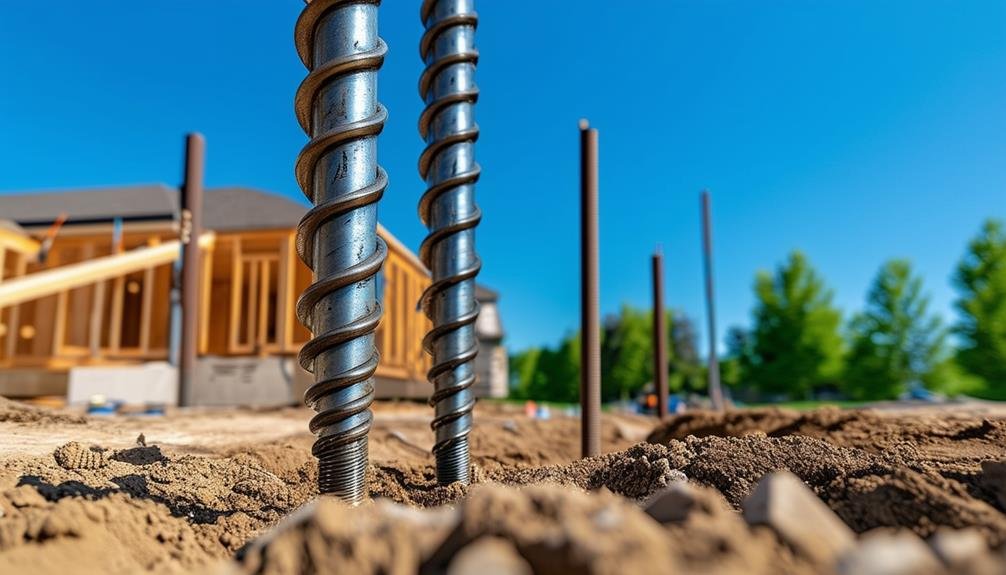
You’ll find that one of the primary benefits of helical piers is their ability to offer fast installation with minimal site disturbance. This makes them perfect for Stoney Creek’s diverse terrains and limited access areas, guaranteeing that your property remains intact during the process.
Helical piers also provide immediate load transfer capability, which means you can move forward with your project without delay.
Another significant advantage is their environmental benefits. Helical piers are less invasive compared to traditional foundation methods, reducing soil displacement and preserving the surrounding ecosystem. They’re a green choice that aligns with sustainable building practices.
When it comes to long term stability, helical piers excel. Their predictable load capacities ensure that both residential and commercial structures in Stoney Creek stand the test of time. This reliability translates to fewer repairs in the future, contributing to overall cost savings.
Time efficiency is another key benefit. The quick installation process not only saves you time but also reduces labor costs, making helical piers a cost-effective solution for new construction and repair projects alike.
Embracing helical piers means joining a community that values innovation, sustainability, and efficient building practices.
Installation Process Overview
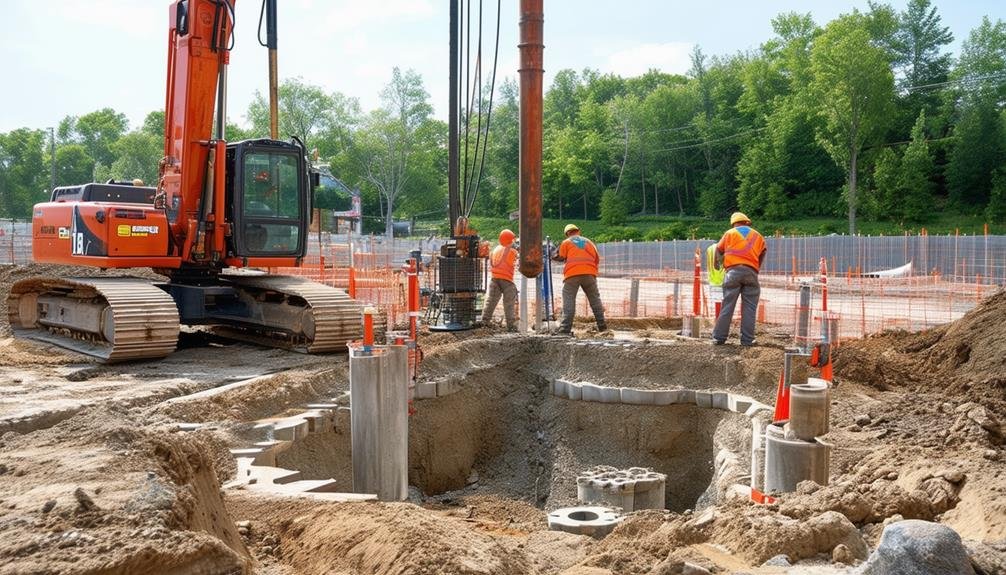
When you’re ready to install helical piers, begin with proper site preparation to guarantee a smooth process.
Next, focus on precise pier placement techniques to meet the project’s design requirements.
Site Preparation Steps
Begin by marking the exact locations for each pier according to the engineering specifications. This guarantees precision and helps in achieving the structural goals.
Once you’ve marked the spots, it’s time to focus on equipment selection. Choose specialized equipment designed to screw the helical piers into the ground efficiently. This equipment minimizes soil excavation, keeping your site clean and reducing disruption to the surrounding area.
Next, prioritize safety measures. Before any heavy machinery is operated, make certain that all team members are briefed on safety protocols. Proper protective gear, like helmets and gloves, should be worn at all times to prevent accidents. Clear communication and a well-coordinated team are crucial to maintaining a safe working environment.
Once you have your equipment ready and safety measures in place, you can proceed with minimal soil excavation. This step is essential in preparing the site without causing unnecessary disturbance.
Documenting each step of the installation process is vital for quality control and assurance. Detailed records will help in verifying that each helical pier meets the required depth and torque specifications. This meticulous approach ensures stability and support for the structure, contributing to the overall success of your project.
Pier Placement Techniques
To properly install helical piers, first identify the correct pile design tailored to your project’s specific needs. It’s crucial to start with thorough soil testing to understand the ground conditions in Stoney Creek, Ontario. This guarantees the pier foundation will be stable and secure. Once you’ve gathered your soil data, choose a helical pier design that can handle the expected loads and soil type.
Next, use specialized equipment to install the helical piers. This machinery helps drive the piers deep into the ground, ensuring a strong foundation. As you’re installing, keep an eye on torque requirements. Meeting these criteria ensures your piers are driven in correctly and will provide the necessary support.
After installation, conduct load tests on each helical pier to verify their capacity and effectiveness. These tests confirm that your pier foundation can handle the structural loads it’s meant to support.
Throughout the process, maintain detailed documentation. This not only aids with quality control but also provides a record that you can refer to for future projects.
Final Installation Checks
Ensuring the stability and effectiveness of your helical pier installation, final installation checks involve verifying torque requirements and conducting load tests to confirm the pile’s capacity. These steps are vital to guarantee that your foundation is solid and dependable. You’re not just finishing up; you’re making sure everything’s been done right, giving you peace of mind and a sense of belonging in a community that values quality and safety.
Torque verification is a key part of this process. Using specialized equipment, you’ll confirm that each helical pier has been installed with the correct torque, indicating it can bear the intended loads. This isn’t just a technicality; it’s essential for the long-term stability of your structure.
Next, you’ll perform load tests. These tests are designed to apply pressure to the piers and check for any signs of weakness or failure. It’s one last confirmation that your installation can handle the weight it’s meant to support.
Soil Conditions in Stoney Creek
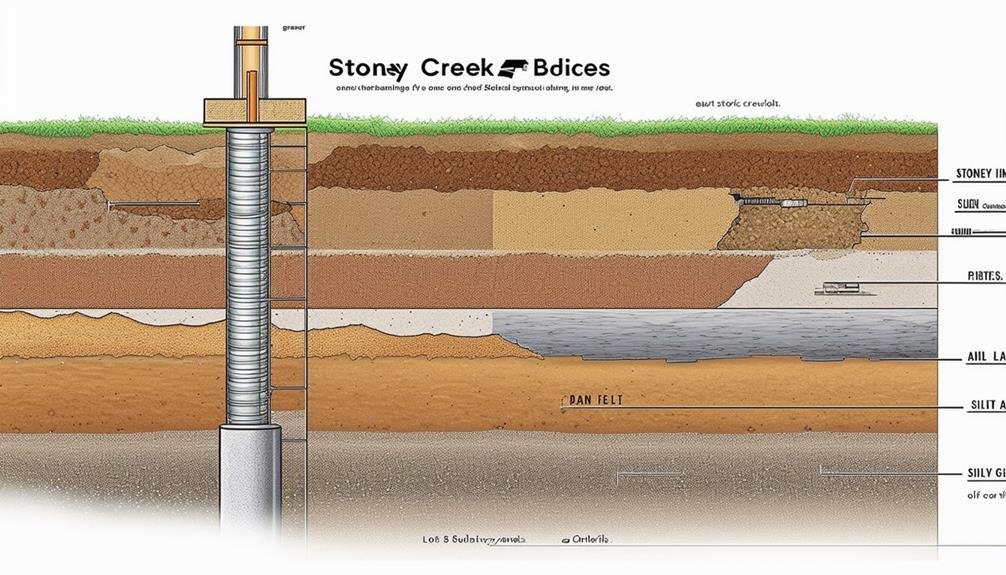
In Stoney Creek, the diverse soil composition of clay, sand, and gravel greatly influences foundation stability and necessitates customized helical pier solutions. You mightn’t realize it, but the soil conditions in this area can vary greatly, even within short distances. This variability means that your foundation needs to be uniquely tailored to handle specific challenges like expansive clay and frost heaving.
Expansive clay can be particularly troublesome because it swells when wet and contracts when dry, putting immense pressure on your foundation. This type of soil requires specialized helical piers that can adapt to these movements without compromising stability.
Similarly, frost heaving—caused by freezing and thawing cycles—can lift and shift the soil, leading to potentially severe foundation issues. Helical piers are designed to address these challenges head-on, ensuring your foundation remains stable year-round.
In your community, where you seek lasting solutions and peace of mind, understanding these soil conditions is crucial. Customized helical piers provide not just a foundation, but also a sense of security and belonging, knowing your home or project is built on solid ground.
Residential Applications
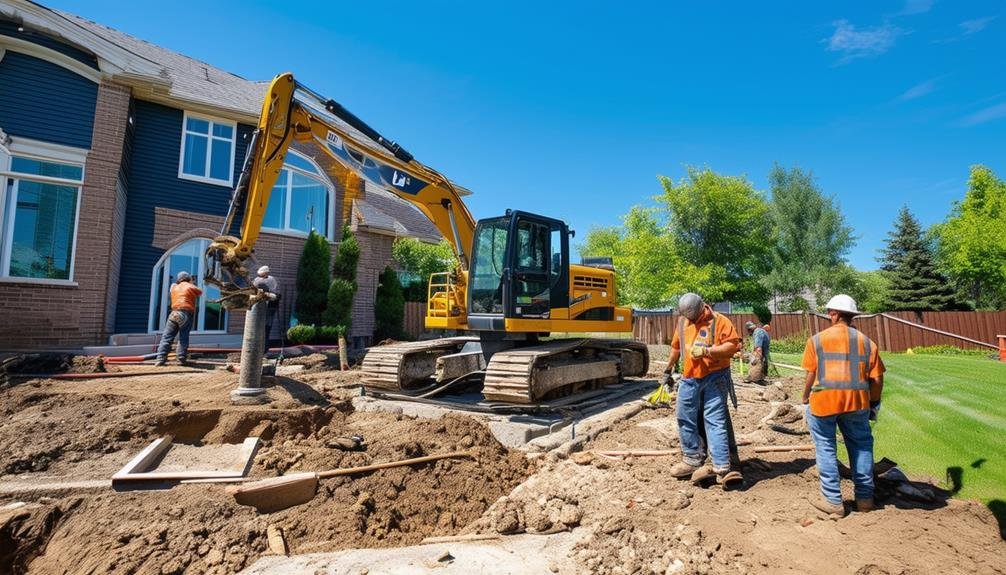
Given these soil conditions, helical piers have become indispensable for residential foundation repairs in Stoney Creek. When you’re dealing with unstable soil, it’s vital to guarantee residential stability. By conducting soil testing, you can determine the best approach for your home’s foundation.
Helical piers offer immediate load transfer capability, meaning your house gets the structural support it needs right away.
Imagine the peace of mind you’ll have knowing your foundation issues are resolved quickly and efficiently. Helical pier installation is a fast process that minimizes site disturbance, allowing you to maintain your daily routine without much hassle. This efficiency makes them a perfect fit for residential projects in Stoney Creek, where community and home comfort are paramount.
Moreover, helical piers are a cost-effective solution for foundation reinforcement. They work well in various soil conditions, ensuring that your home remains stable and secure. By opting for these structural solutions, you’re investing in the long-term health of your house.
You’re not just fixing a problem; you’re ensuring a safe and stable environment for your family. Helical piers truly provide the foundation reinforcement you need for a worry-free home.
Commercial Applications
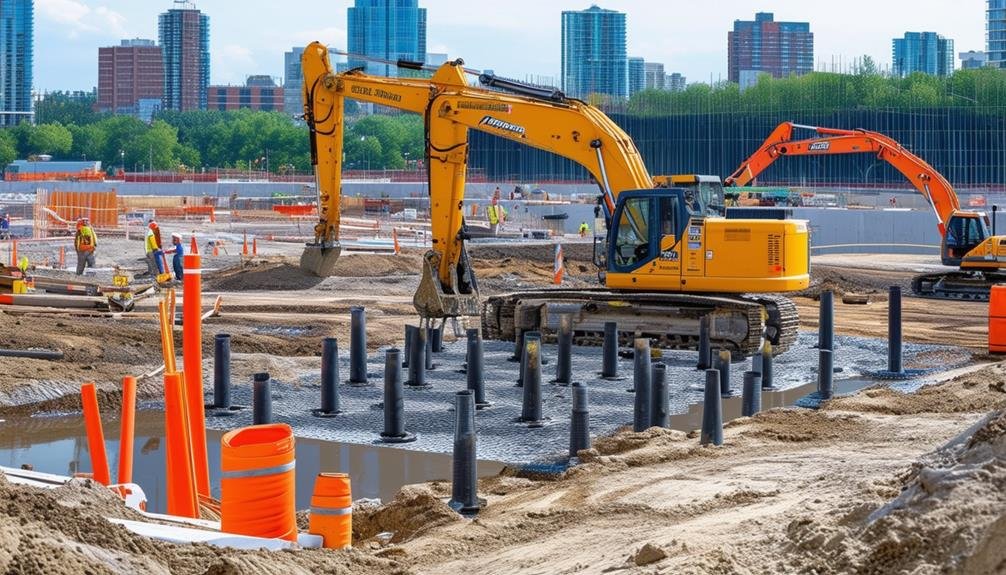
When it comes to commercial construction projects in Stoney Creek, helical piers offer a reliable and efficient solution for foundation support. Whether you’re building infrastructure, setting up solar panels, or undertaking seismic retrofitting, these versatile piles can handle a variety of structural requirements.
You’ll appreciate the minimal site disturbance during installation, which keeps your project timelines on track and reduces the headache of unexpected delays.
In terms of cost analysis, helical piers often prove to be a more economical choice. Their efficient installation process means fewer labor hours and less heavy machinery, translating to lower overall expenses. Plus, the immediate load transfer capability means you can move forward with construction activities without waiting for concrete to cure, further optimizing your schedule.
Maintenance considerations are also favorable with helical piers. Their robust design ensures long-term durability, reducing the need for frequent inspections and costly repairs. This makes them an ideal choice for commercial projects where reliability and low maintenance are paramount.
Choosing a Contractor
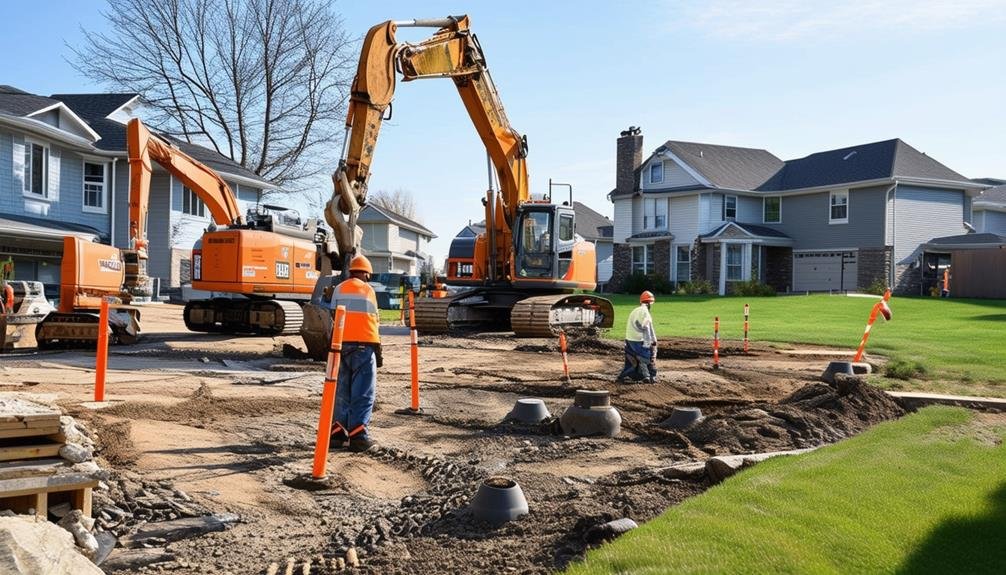
When choosing a contractor for helical pier installation, start by verifying their credentials and certifications.
Look into their past projects to assess their experience and success rates.
Verify Contractor’s Credentials
Always verify the contractor’s certification and accreditation to confirm they’re qualified for helical pier installation in Stoney Creek. Confirming that the contractor holds the proper credentials is essential for a successful project. You want someone who meets all the necessary contractor qualifications and has undergone accreditation verification. This step not only guarantees their expertise but also provides peace of mind knowing that you’re working with a professional.
Check their experience and track record with helical pier projects specifically in the Stoney Creek area. A contractor familiar with local conditions and requirements is better equipped to handle any unique challenges that may arise. Additionally, look for reviews and testimonials from previous clients. These insights can help you gauge the quality of work and customer satisfaction, making you feel more connected and confident in your choice.
Don’t forget to make sure that the contractor has the necessary insurance coverage and permits for the job. This protects you from potential liabilities and ensures that the installation meets local regulations. Requesting references and examples of past work can further affirm their expertise and workmanship, making you feel part of a trusted community.
Assess Previous Projects
To choose the right contractor, start by reviewing their portfolios to assess their experience with helical pier installations in Stoney Creek. Look for evidence of successful completion of similar projects in the area. This shows their expertise and familiarity with local conditions, which can be vital for the project’s success.
Evaluate the contractor’s credibility by examining past projects’ performance. Check for detailed case studies or project summaries that showcase their proficiency. Additionally, seek out testimonials or references from previous clients. Positive feedback on their helical pier installation work can give you confidence in their abilities and their commitment to quality.
Pay attention to the quality of materials and equipment used by the contractor. High-quality materials and state-of-the-art equipment often indicate a commitment to long-lasting, reliable installations.
Don’t overlook the importance of adherence to safety protocols and regulations. A contractor who prioritizes safety demonstrates professionalism and a responsible approach to their work.
Request Detailed Estimates
After evaluating previous projects and verifying a contractor’s credibility, the next step is to request detailed estimates from multiple contractors to compare pricing and services for helical pier installation in Stoney Creek.
You’ll want to make sure these estimates include all costs involved, allowing for a thorough cost comparison. This way, you can clearly see what each contractor offers and decide which one aligns best with your budget and needs.
Ask for a detailed breakdown of the installation timeline and any potential additional expenses. This will help you avoid unexpected costs and delays. It’s important to understand what each contractor includes in their service offerings, so you’re not caught off guard by hidden fees.
Don’t forget to verify the warranty coverage provided by each contractor. A solid warranty offers peace of mind, knowing that any issues with the installation will be addressed promptly.
Additionally, seek clarification on the specific helical pier design and materials proposed. High-quality pier materials ensure the longevity and stability of your installation.
Frequently Asked Questions
How Much Does It Cost to Install Helical Piers?
You’re probably wondering about the cost. It varies due to cost factors like foundation damage, soil conditions, and pier numbers. Pricing variability means you could spend between $3,000 to $10,000, depending on your specific project needs.
Are Helical Piers Cheaper Than Concrete?
Yes, helical piers can be cheaper than concrete. When you look at the material comparison, helical piers often offer long-term savings due to reduced excavation, immediate load-bearing capacity, and faster installation, making them a cost-effective choice.
Can You Install Helical Piers Yourself?
You shouldn’t install helical piers yourself. DIY tools can’t match the precision needed, and without proper safety precautions, you risk compromising your foundation. Trust the professionals to guarantee your home’s stability and your peace of mind.
How Long Does It Take to Install Helical Piers?
You’re looking at an installation timeline of 1-2 days for helical piers. Soil conditions and the number of piers needed might affect this, but overall, it’s a quick and minimally disruptive process for stabilizing your home.
Conclusion
In Stoney Creek, Ontario, helical piers offer a robust solution for diverse soil conditions, ensuring stable foundations for any project. They provide immediate load transfer, long-term stability, and are cost-effective with minimal site disturbance.
Whether it’s for residential, commercial, or infrastructure needs, choosing helical piers means you’re investing in reliability and peace of mind. So, when you’re ready to build or repair, trust helical piers to keep your structures secure and standing strong.
